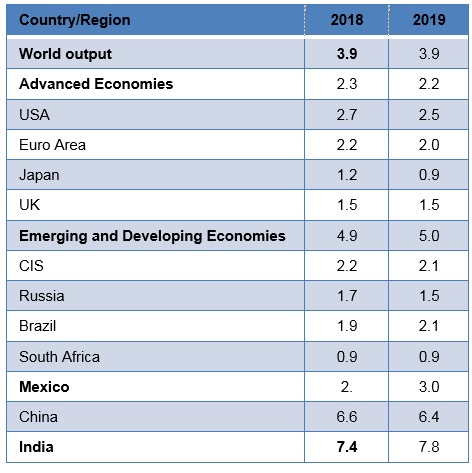 By Dr. V K Vijayakumar
By Dr. V K Vijayakumar
The twin shocks of demonetization and GST implementation impacted India’s growth rate. Growth rate troughed at 5.7 percent in Q1 FY2018 but recovered subsequently. We may end the year with a respectable growth rate of 6.8 percent. The low fiscal and current account deficits provided macro stability to the economy resulting in low inflation and exchange rate stability during FY 2018. This is in danger of being threatened by the recent spike in crude.What is in store for the economy in FY 2019 and beyond?
There are clear indications that the economy is on a rebound. There is a global consensus that India would reemerge as the fastest growing large economy in the world in 2018. See the projections of the IMF.
Global Economic Outlook, Growth 2018, 19 (P): IMF

Global growth, according to the IMF, rose to 3.7 percent in 2017- the most impressive growth since the Great Recession of 2008-09. The IMF expects global growth to get better at 3.9 percent for this year and next. As can be seen from the table, among the large economies, India is projected to achieve the best acceleration in growth.
Globally, the environment for growth recovery continues to be favorable. US is powering ahead with an impressive growth rate of 2.7 percent. Unemployment in US is at a 40-year low at 3.9 percent. Inflation is under control at around 2 percent. Europe is stable and China is slowly decelerating. International trade has picked up assisting global growth recovery.
In India, GDP growth troughed at 5.7 percent in Q1 FY18 and from there accelerated to touch 6.3 percent and 7.2 percent in Q2 and Q3 respectively. IIP, which has been above 7 percent since November 2017, has marginally slipped to 5 percent in April. CPI inflation is under control at 4.5 percent. Q4 corporate results are good and indicate strong revival in rural and urban consumption. GST collections in April crossed Rs 1 lakh crores for the first time. We are likely to end FY 2018 with growth rate of 6.8percent. Growth is likely to accelerate to around 7.5 percent in FY 2019. However, there are some major headwinds that might impact this expected recovery.
Crude realities
The major worry is the recent sharp spike in crude. Crude has risen by more than $ 10 a barrel since April. The RBI had assumed a rate of $68 for 2018 but Brent crude is now hovering around $80. Every $10 rise in crude raises India’s inflation by 10bp and negatively impacts GDP growth by 30bp. Therefore, if the high prices sustain, that will be a source of worry. India’s trade deficit, current account deficit and fiscal deficit will deteriorate. The ‘twin deficit issue’ will come back to haunt the policy makers. RBI will turn more hawkish. Already the 10-year bond yield has spiked to around 8 percent. This sharp jump in the cost of capital is negative macro news.
There is no more room for passing the burden of the crude price rise on to the consumers. The Government has gone on record that excise reduction will be considered if crude goes beyond $75. Therefore, some excise duty cuts are on the cards. This is inevitable when elections are fast approaching. But the flipside to the excise cut is that it will expand the fiscal deficit. The government turning more populist as election approaches is another worry.
Rate hike in the offing?
The benign inflation scenario, which the RBI projected in the last policy, is unlikely to last. RBI’s projection of 4.4 percent inflation for FY 2019 assumed crude at $68. Apart from the crude spike, there are other important factors like the proposed hike in MSP, narrowing of the output-gap and the depreciating rupee that will trigger inflation. The RBI will certainly turn hawkish in the June policy and the present trends indicate 2 rate hikes this year. This is not good news from the market perspective.
Credit woes
As the economy accelerates, credit demand would pick up. The PSU banks, which accounts for 70 percent of India’s banking system, are totally unprepared to meet the credit demand. The regulatory and investigative overkill along with capital constraints have hugely impacted the PSU banking system. Of course, this is good news for the healthy private sector banks and NBFCs.
The correction in small and mid-caps
We have been advising investors, consistently for some time now, to prefer large-caps to small and mid-caps. The excessive valuations of the small and mid-caps had crossed levels of safety, rendering them vulnerable to correction. This has happened now. Mutual fund restructuring also has contributed to this correction. As on May 18th, the small-cap index is down 14.06 percent and the mid-cap index is down 10.61 percent while the Nifty is up 0.61 percent for the year. Some small and mid-caps have been butchered. If the market corrects further, this segment is likely to bear the brunt of selling and price erosion. This will also provide some good buying opportunities in quality small and mid-caps.
We are headed for volatile days. Since valuations for markets globally are at elevated levels, there is a risk of correction at any time. Emerging markets particularly are vulnerable to capital flight that can be triggered by the rising bond yield in the US. The domestic political scene is turning foggy. The incessant flow of money into our markets through mutual funds, particularly SIPs, is imparting great resilience to our markets. Also, corporate earnings are set for sharp revival. Therefore, there is certainly room for optimism; but the investor stance should be, ideally, cautiously optimistic and the investment strategy should be conservative and defensive in 2018.







